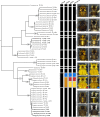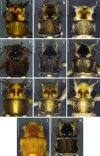Perlidae (Plecoptera) from the Paranapiacaba Mountains, Atlantic Forest, Brazil: Diversity and implications of the integrative approach and teneral specimens on taxonomy
- PMID: 33301489
- PMCID: PMC7728281
- DOI: 10.1371/journal.pone.0243393
Perlidae (Plecoptera) from the Paranapiacaba Mountains, Atlantic Forest, Brazil: Diversity and implications of the integrative approach and teneral specimens on taxonomy
Abstract
The study of complementary sources of biological variation (e.g. morphological, molecular) has allowed a better understanding of biodiversity through the construction of an integrative taxonomy. Using this approach, specimens from the Paranapiacaba Mountains, southeastern Brazil, were studied to update the knowledge on the stonefly family Perlidae from the region, characterize the species, and make associations between nymphs and adults using a fragment of the mitochondrial cytochrome c oxidase subunit I (COI) gene. The study also discusses the implications of integrative taxonomy and teneral specimens for the study of South American Perlidae. The molecular data were analyzed using Bayesian inference, Neighbor-joining, and delimiting species methods. Our results revealed that, in general, there was a morphological and molecular congruence between species. In the Paranapiacaba Mountains, three genera and 15 species were recorded: Anacroneuria boraceiensis Froehlich 2004, A. debilis (Pictet 1841) (new record), A. fiorentini De Ribeiro and Froehlich 2007 (new record), A. flintorum Froehlich 2002, A. iporanga Bispo and Froehlich 2004, A. itajaimirim Bispo and Froehlich 2004, A. polita (Burmeister 1913), A. subcostalis Klapálek 1921, A. tupi Bispo and Froehlich 2004 (with a description of the nymph), Kempnyia auberti Froehlich 1996, K. colossica (Navás 1934), K. flava Klapálek 1916, K. neotropica (Jacobson and Bianchi 1905) (including its new junior synonym K. petersorum Froehlich 1996), Kempnyia sp., and Macrogynoplax veneranda Froehlich 1984. COI sequences were obtained for 11 species, five of which had nymphs associated with adults. Among the five associated nymphs, the nymph of A. tupi is described here. The results of this study indicate that the color of adult teneral specimens differs from that of mature specimens. Given this, the synonym of K. neotropica and K. petersorum was proposed since these species have high morphological and molecular similarities and differ only in color patterns. In addition, the previous record of A. petersi Froehlich 2002 from the Paranapiacaba Mountains was invalidated since it was considered a teneral specimen of A. flintorum. These results suggest that the development of an integrative taxonomy is essential to continue advancing the study of Perlidae diversity in South America.
Conflict of interest statement
The authors have declared that no competing interests exist.
Figures










References
-
- Pessacq P, Zuñiga MDC, Duarte T. An updated checklist of Neotropical Plecoptera. Zoosymposia. 2019;16: 182–209. 10.11646/zoosymposia.16.1.15 - DOI
-
- Froehlich CG. Catalogue of Neotropical Plecoptera. Illiesia. 2010;6: 118–205.
-
- Pictet FJ. Histoire naturelle générale et particulière des insectes névroptères. Famille des Perlides. Genève: J. Kessmann; 1841. 10.5962/bhl.title.124172 - DOI
-
- Enderlein G. Klassifikation der plecopteren sowie diagnosen neuer gattungen und arten. Zool Anz. 1909;34: 385–419.
Publication types
MeSH terms
Substances
LinkOut - more resources
Full Text Sources

